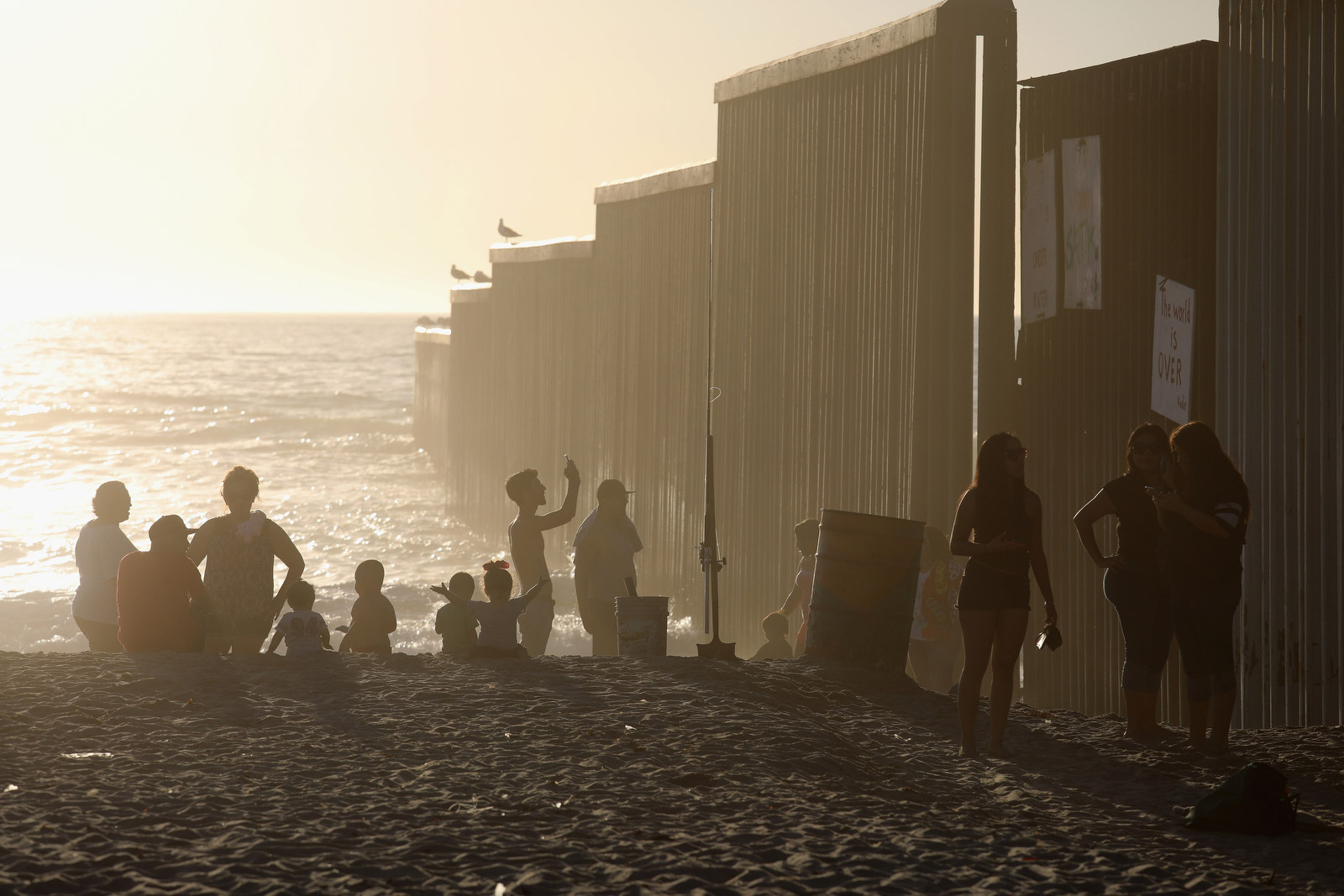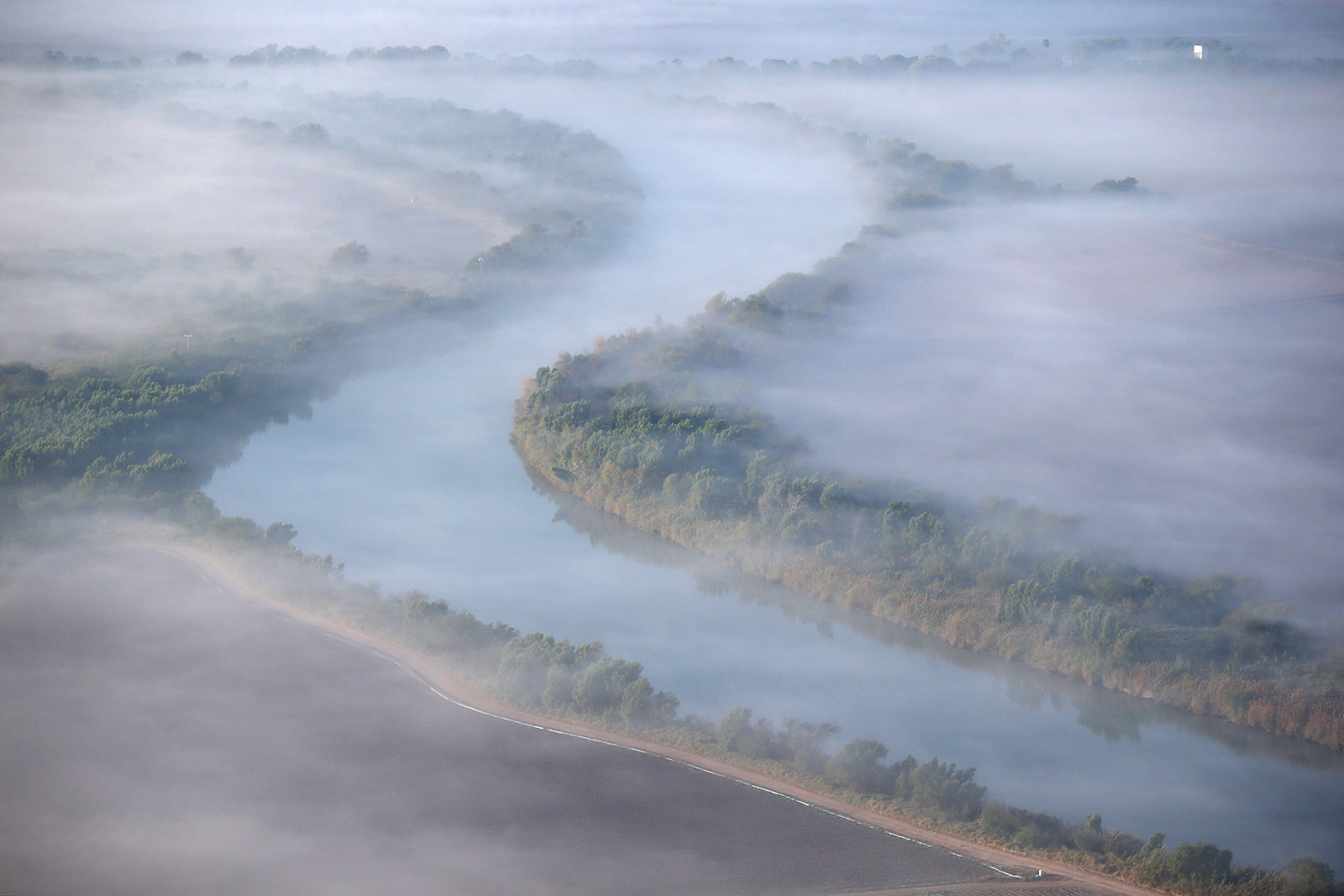The US-Mexico border fence stretches into the countryside near Nogales, Arizona, in March 2013.
The United States’ southern border with Mexico is 1,933 miles long, stretching from the Pacific Ocean to the tip of South Texas.
Some 700 of those miles have fencing in place.
That’s not enough for President Donald Trump, who promised during his campaign to build a border wall.
Photographer John Moore has driven “every inch” of the border while covering the immigration issue for over a decade. He’s spent time on both sides, tagging along with Border Patrol agents and migrants.
Through his photos, you can see how the fencing varies greatly on different parts of the border.

People in Tijuana, Mexico, enjoy a late afternoon on the beach in September 2016.

A fog hovers over the Rio Grande near La Grulla, Texas, in December 2015.
Out west, between San Diego and Tijuana, Mexico, there’s high double fencing to deter people from crossing illegally. Part of the fence goes right through the beach and continues into a section of the Pacific Ocean.
Further east, in Texas, there’s often no fencing at all. The Rio Grande and the rugged terrain around the river serve as a natural barrier.
In between, there’s an assortment of fences with different shapes, sizes and materials. These fences do not all connect to form one continuous line. There are some areas that have no fencing at all.

A US Border Patrol vehicle monitors an opening in the border fence near McAllen, Texas, in January 2017.
But US Border Patrol agents have all sorts of high-tech surveillance equipment to help them, from motion-sensor cameras to drones to tethered aerostat balloons that fly high over the border and provide a 360-degree view of the border 24/7.
“There's no doubt that fencing is a deterrent, but it's just part of a larger, more holistic approach that Homeland Security takes toward border security,” Moore said.
Here’s what the border looks like in different cities along its path, from west to east:

San Diego, California

The border fence separating San Diego from Tijuana, Mexico, extends into the Pacific Ocean in May 2017. Moore said the area is heavily surveilled from the American side, with tower-mounted cameras and frequent helicopter patrols. “Occasionally someone tries to swim around the fence, but often they have to get rescued or they are quickly taken into custody by Border Patrol agents,” he said. “It’s one of the most secure spots of the entire US-Mexico border.”

The fence separating San Diego, left, from Tijuana stops at the side of a large hill in May 2017. “Customs and Border Protection often does not have agents all along the border,” Moore said. “However, they know the terrain features of certain regions. So although many undocumented immigrants can actually cross over the border, the terrain often funnels people through certain areas. And that's where the Border Patrol frequently sets up its checkpoints.”

Tijuana, Mexico

A US Coast Guard patrol is seen from Tijuana as it flies over border fencing in November 2018.

Migrants shower outside a temporary shelter that was set up near the border fence in November 2018.

Maria Elena Carrillo holds her 3-year-old daughter, Camilla Escalante, while speaking through the border fence in Tijuana in May 2016. The US Border Patrol tightly controls the San Diego side, and during specific weekend hours it allows visitors to speak to loved ones through the fence at an area called Friendship Park.

Jacumba Hot Springs, California

A US Border Patrol vehicle patrols the fence in Jacumba Hot Springs, California, in September 2016. “In certain areas there still exists what's known as landing-mat fencing,” Moore said. “The landing mats are corrugated metal of, in fact, surplus material from the Vietnam War, which originally were intended to be used as landing mats for helicopters in Vietnam and was later repurposed as US-Mexico border fencing. … The landing-mat fencing is shorter in height and you can't see through it, which causes difficulties for Border Patrol agents because they can't physically see what's on the other side.”

The border fence stops at a hillside in Jacumba Hot Springs in September 2016.

Mexicali, Mexico

A painting of an Aztec warrior adorns the Mexican side of this fence in September 2016. Since 2007, Moore said, the US government has been working to replace this kind of landing-mat fencing because of the dangers it poses to Border Patrol agents. One danger is “rocking incidents,” where people on one side of the fence throw large rocks at agents who can’t see them from the other side.

Felicity, California

A US Border Patrol agent walks along the border at the Imperial Sand Dunes, near Felicity, California, in November 2016. The 15-foot border fence, also known as the “floating fence,” sits atop the dunes and moves with the shifting sands.

Mexico is seen over the border fence at the Imperial Sand Dunes in November 2016.

Tohono O'odham Reservation, Arizona

Young men walk along the Mexican side of the fence in a remote area of the Sonoran Desert, near the Tohono O'odham Reservation in Arizona in December 2010. “In Arizona, I've photographed hundreds of miles of what's known as a vehicle barrier,” Moore said. “It's essentially a series of bars in the ground that keep vehicles from coming across. But they do nothing to stop people. This type of fencing is mostly used in remote areas.”

Nogales, Arizona

Children on the Mexican side of the fence look into Nogales, Arizona, in July 2018.

US Border Patrol ranch liaison John "Cody" Jackson, right, rides with cattle rancher Dan Bell on Bell's ZZ Cattle Ranch in March 2013. Jackson meets regularly with local ranchers to coordinate the agency's efforts on border issues.

The border fence is seen at sunset in Nogales in July 2018.

Sunland Park, New Mexico

Different forms of fencing meet at the border near Sunland Park, New Mexico, in August 2017.

A border marker stands along the fence in October 2016. Workers were upgrading the fencing in the area to combat smugglers and illegal crossings.

El Paso, Texas

Ciudad Juarez, Mexico, is seen from the Texas side of the border in October 2016. The Rio Grande serves as the border here. "The Rio Grande is a natural border, has been since 1848, and the ties between cities and towns on either side are strong,” CNN’s Gregory Krieg reported.

Fort Hancock, Texas

The U.S.-Mexico border fence stops while passing through farmland near Fort Hancock, Texas, in October 2016. Throughout vast stretches of West Texas, the fence starts and stops along the bank of the Rio Grande, which is often nearly drained due to crop irrigation.

Lajitas, Texas

Golfers play near the border in October 2016. The top-rated course Black Jack's Crossing, at the luxury Lajitas Golf Resort, was opened in 2012 and built on the banks of the Rio Grande in Texas' remote and rugged Big Bend region.

The Rio Grande winds through the Santa Elena Canyon in the Big Bend region near Lajitas in August 2017. Big Bend is a formidable natural barrier, Moore said, that doesn’t require the manpower and border security of more urban areas. But some people still try to cross it “because that's where the Border Patrol is not. So even as we've seen the number of border crossers decrease over the last 20 years, the number of deaths while crossing the border has not decreased.”

La Joya, Texas

US Border Patrol agent Sal De Leon stands near a section of the border fence while on a patrol in La Joya, Texas, in April 2013. La Joya is in the Rio Grande Valley, which Moore says has sporadic fencing because of the river and is the No. 1 area for border crossings.

Mission, Texas

A man returns to the Mexican side of the border after washing his horse in the Rio Grande, near Mission, Texas, in July 2014. Migrants typically cross the river by raft, Moore said.

A Customs and Border Protection helicopter flies over the border in Mission in November 2018.

McAllen, Texas

US Border Patrol agents question undocumented immigrant families while taking them into custody near McAllen, Texas, in February 2018. A group of men, women and children from Central America had crossed the Rio Grande to seek asylum.

A US Border Patrol agent removes a ladder that undocumented immigrants used to climb a border fence near McAllen in October 2016. “One of the challenges with relying on fences and potentially walls is that bigger ladders can be built,” Moore said.

Brownsville, Texas

The Mexican border town of Matamoros is seen on the Rio Grande, across the border from Brownsville, Texas, in May 2013. The Rio Grande Valley has lots of dense mesquite thickets near busy population centers, and that often provides easy hiding spots for people trying to cross the river, Moore wrote in his recent book “Undocumented.”
John Moore is a Getty Images photographer based in New York. He has spent the past decade covering immigration from both sides of the US-Mexico border. Follow him on Instagram and Twitter.
Photo editor: Brett Roegiers
No comments:
Post a Comment